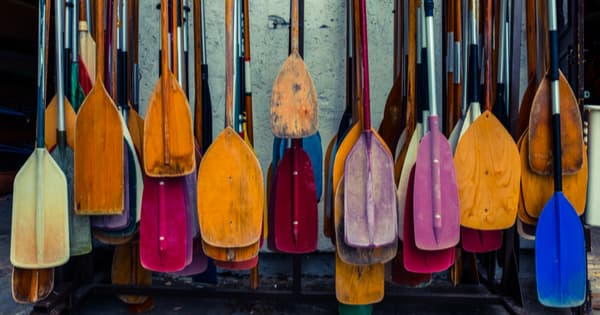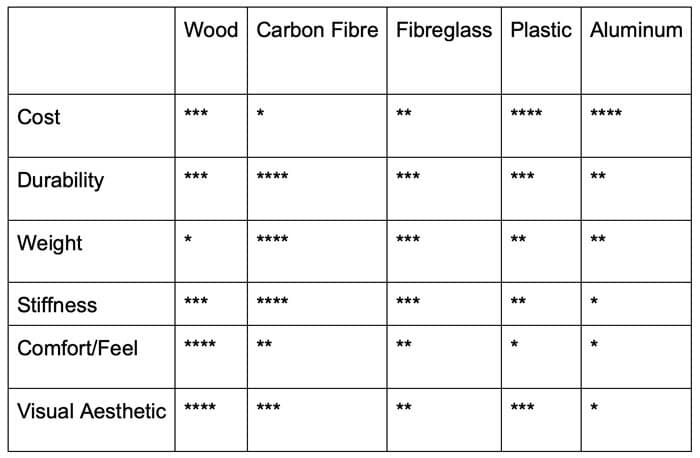How to Choose a Whitewater Canoe Paddle
I had an argument with my 10-year-old son the other day about spending $200 on a hockey stick. I heard myself say to him, “ 40 years ago, everyone used wooden sticks. Before that, hockey sticks didn’t even have a curved blade. Those guys had just as much fun playing hockey”. Then I walked past my Werner Bandit carbon fibre canoe paddle leaning in the corner of the mudroom. I realized – you can have just as much fun paddling whitewater with a basic $25 canoe paddle – but having a good blade with the characteristics you value enhances your skills and makes the activity that much MORE enjoyable.
Materials

For whitewater canoeists, having the right paddle will maximize your skills for the best performance on the river. The material your paddle is made from determines many of its characteristics. The most common materials used to build whitewater canoe paddles are wood, fibreglass, carbon fibre, plastic and aluminum.
More than one of these materials is often used in a single paddle.
For example, a plastic blade and grip with an aluminum shaft, or a wooden blade and grip with a carbon fibre shaft. Whether in the grip, shaft, or blade each of these materials has key characteristics that result in benefits and drawbacks to paddle performance.
6 factors to consider when choosing a paddle
The following 6 factors are key to consider when choosing a paddle. Finding the right balance of these characteristics will have you happy and ripping with your new blade.
Cost
Your budget is probably the biggest determining factor in choosing a paddle. The price of a whitewater canoe paddle varies from $25 - $500. You don’t need a top of the line paddle to make hot moves on the river. However, your paddle can limit you in terms of power, stamina and finesse. Paddles made from plastic and aluminum are the most economical. Paddles made from carbon fibre are generally the most expensive. If you are an intermediate or advanced paddler it is worthwhile investing in a mid to higher range priced paddle. You can get a decent whitewater paddle for under $200, such as the Aqua Bound Edge Carbon Canoe Paddle.
Durability
A whitewater canoe paddle takes a beating. It gets jammed into rocks (over and over again), used as a pry bar on the gunwale of your canoe, and gets pushed and pulled against the water hundreds of times per day. If your paddle breaks it may mean a nasty swim, a long hike, or some serious downriver improvising. Consider durability for reliability and longevity. All of the materials mentioned above have different qualities of durability. Carbon fibre and fibreglass are strong but brittle, aluminum is strong till it bends and wood, reinforced with epoxy resins and well maintained can last forever.
Weight
The lighter your paddle is, the longer you can go without getting tired and your recovery is quicker for the next stroke. Lighter is better. The balance between weight and durability is the challenge for the paddle designer. Generally carbon fibre paddles are the lightest. Fibreglass has many of the same qualities but is heavier. Wood paddles are generally heaviest.
Stiffness
The stiffer the paddle, the stronger the stroke. But, too stiff a paddle can be exhausting to paddle with. When you pull your paddle through the water the paddle absorbs some of the force by flexing. The more it flexes, the less power is transferred to the water and as a result, less impact on the direction of the boat. However, this flex in the paddle also reduces the strain on your joints and muscles. Some combination of wood and carbon fibre/fibreglass will provide a stiff shaft. A carbon blade will complete a stiff paddle. If you are going for a new paddle, up the stiffness but do it incrementally over a couple seasons. Jumping from a super flexible paddle to a super stiff paddle all at once can cause tendonitis and other joint injuries. If you have been using a flexible paddle, try a carbon (or fibreglass) shaft with a plastic blade.
Comfort and Feel Aesthetic
Your paddle should not give you cuts or blisters. It should feel good in your hands. The grip should fit your palm and the shaft should fit your grip comfortably. Many paddlers prefer the feel of wood; it is warmer on the hands in cold weather.
Visual Aesthetic
This really comes down to personal preference and generally does not impact your paddle’s function. This doesn't mean looks are irrelevant. The more you like the look, the more you're likely to love your paddle. You will find the most variety of colours and designs in plastic blades - but wood - the stuff of the traditional paddle, can be beautiful as well.
Comparison Chart
The following chart compares each material’s attributes with the desired characteristics of a whitewater paddle. One star – not so good, 4 stars really good.

Read Whitewater Canoe Paddle Reviews from top brands like Werner and Bending Branches >
In order to choose the right whitewater paddle, consider the 6 factors and decide what is important to you. Using the chart, narrow down the combination of materials your paddle will be made from. I wanted a stiff, light, durable paddle and chose one with a full carbon fibre blade and shaft. If you're looking for a high performance super durable paddle, check out Echo Paddles for some of the best whitewater canoe paddles on the market. Ideally you can try out some paddles, or at least “dry-try” them at your local paddling shop and find what feels best.
Inspired by wanderlust and a passion for rivers, Adrian's paddling addiction has taken him across the globe. After pursuing his degree in Outdoor Recreation and Tourism Management, Adrian eventually settled in Palmer Rapids, Ontario. Here, he has worked for over a decade as the Director Of Operations at The Boundless School.
Related Articles
It was mid-April, circa 2002. There were still patches of snow in the forest. It was one of those days…
We’ve all been there before. All through the cold months we dream of putting the heavy coats and extra…
Have you checked the price of canoe paddles lately? Good ones cost over $100; great ones approach $300…
Narrowing down the best whitewater canoe options can be difficult. To narrow it down to models that have…



